Impact of Digital Smell Technology on Marketing Strategies Report
VerifiedAdded on 2020/02/19
|20
|4570
|116
Report
AI Summary
This report, titled "XYZ DIGITAL SMELL TECHNOLOGY," investigates the impact of digital scent technology on user emotions and marketing strategies. The study, conducted at Harvard University's Computer laboratory, explores the evolution of digital scent, including hardware like iSmell and scentography, and applications in marketing such as aroma billboards and thematic smells. The research aims to assess the impact of smells on emotional appeal and memory, determine how scent is transmitted via the internet, and establish the effects of digital scent technology on marketing. The research methodology includes a descriptive research design, stratified random sampling, and data collection through interviews and questionnaires. Ethical considerations, limitations, and the significance of digital smell technology are also addressed, offering a comprehensive overview of the subject and its potential in the digital landscape.
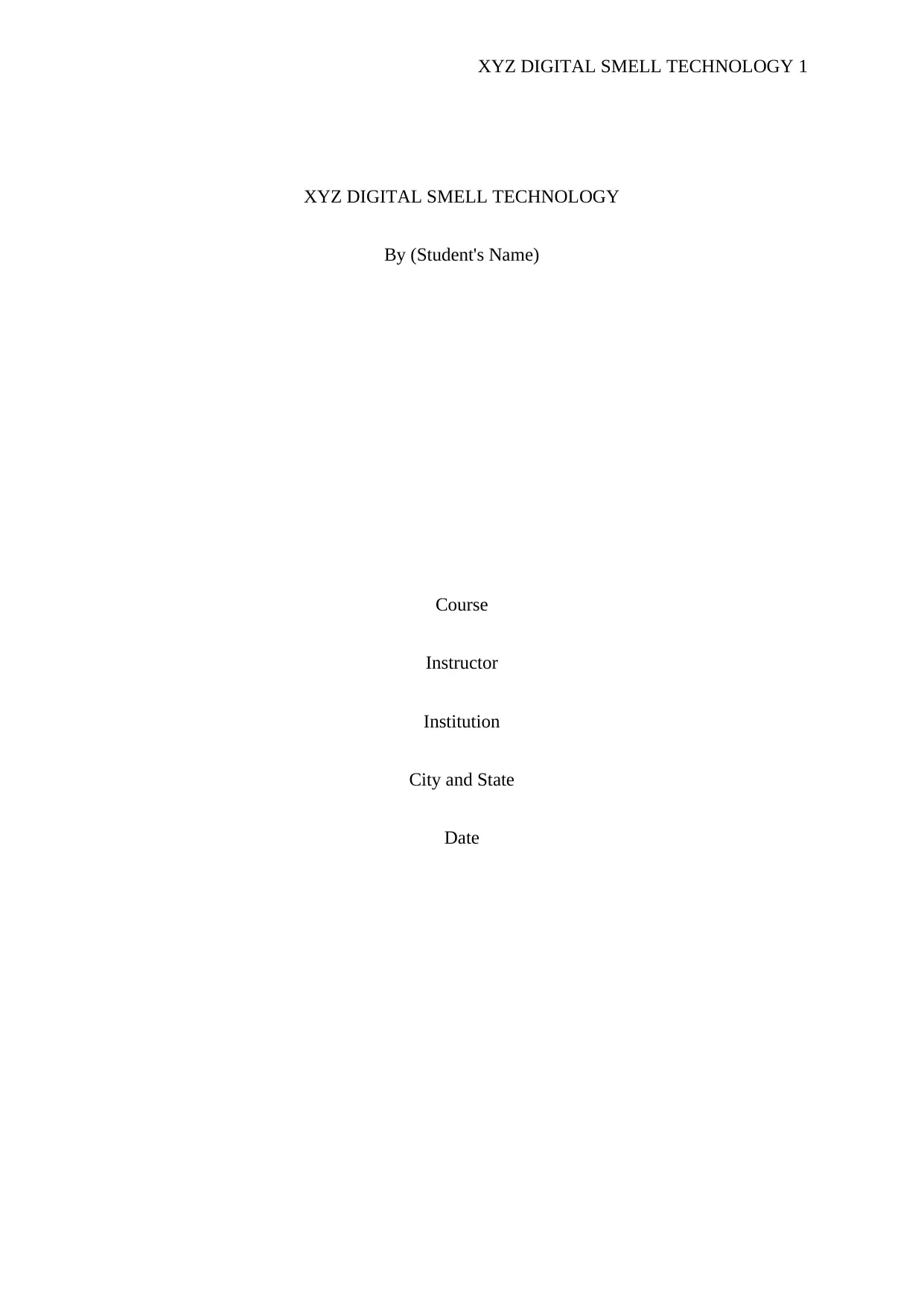
XYZ DIGITAL SMELL TECHNOLOGY 1
XYZ DIGITAL SMELL TECHNOLOGY
By (Student's Name)
Course
Instructor
Institution
City and State
Date
XYZ DIGITAL SMELL TECHNOLOGY
By (Student's Name)
Course
Instructor
Institution
City and State
Date
Paraphrase This Document
Need a fresh take? Get an instant paraphrase of this document with our AI Paraphraser
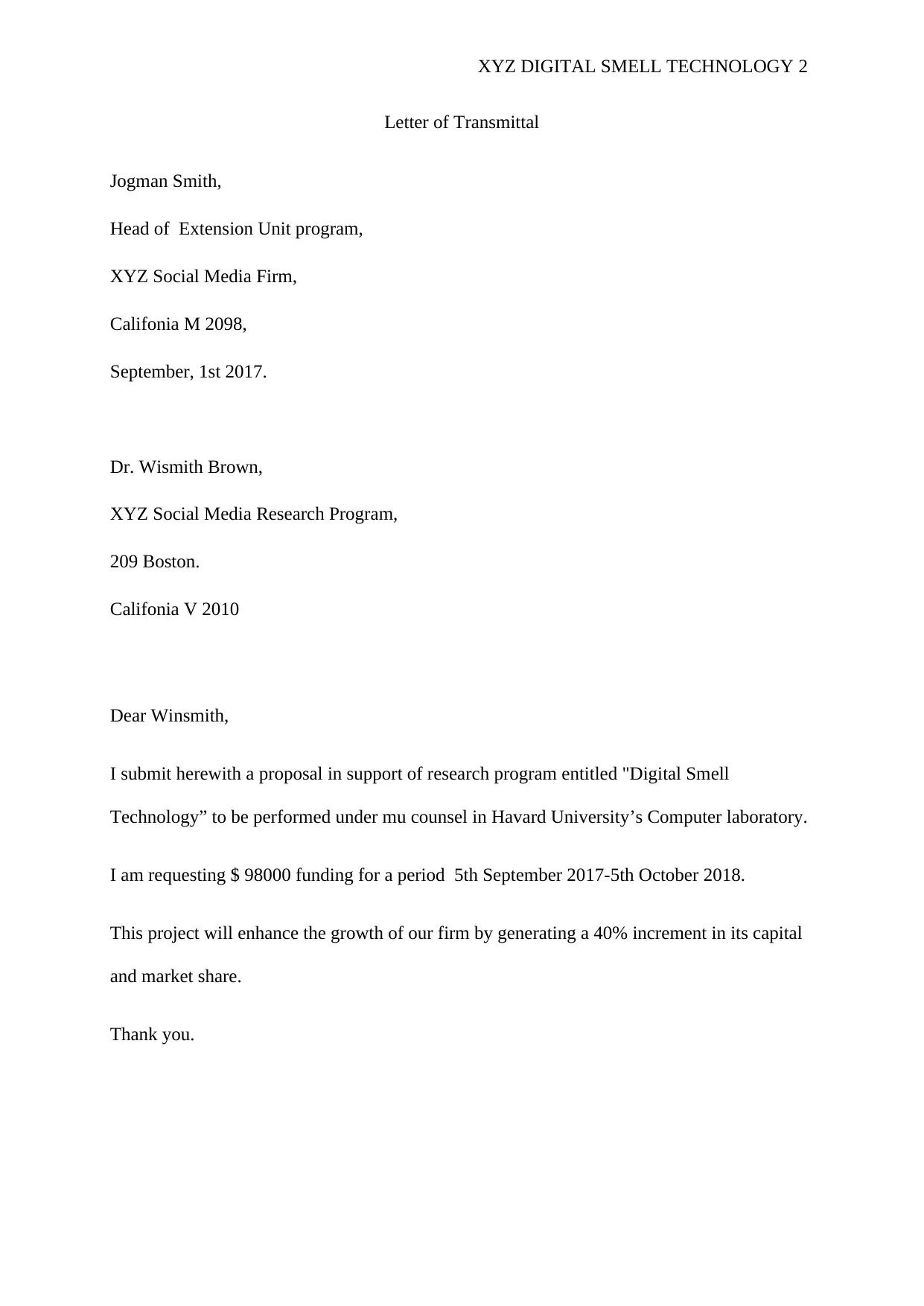
XYZ DIGITAL SMELL TECHNOLOGY 2
Letter of Transmittal
Jogman Smith,
Head of Extension Unit program,
XYZ Social Media Firm,
Califonia M 2098,
September, 1st 2017.
Dr. Wismith Brown,
XYZ Social Media Research Program,
209 Boston.
Califonia V 2010
Dear Winsmith,
I submit herewith a proposal in support of research program entitled "Digital Smell
Technology” to be performed under mu counsel in Havard University’s Computer laboratory.
I am requesting $ 98000 funding for a period 5th September 2017-5th October 2018.
This project will enhance the growth of our firm by generating a 40% increment in its capital
and market share.
Thank you.
Letter of Transmittal
Jogman Smith,
Head of Extension Unit program,
XYZ Social Media Firm,
Califonia M 2098,
September, 1st 2017.
Dr. Wismith Brown,
XYZ Social Media Research Program,
209 Boston.
Califonia V 2010
Dear Winsmith,
I submit herewith a proposal in support of research program entitled "Digital Smell
Technology” to be performed under mu counsel in Havard University’s Computer laboratory.
I am requesting $ 98000 funding for a period 5th September 2017-5th October 2018.
This project will enhance the growth of our firm by generating a 40% increment in its capital
and market share.
Thank you.
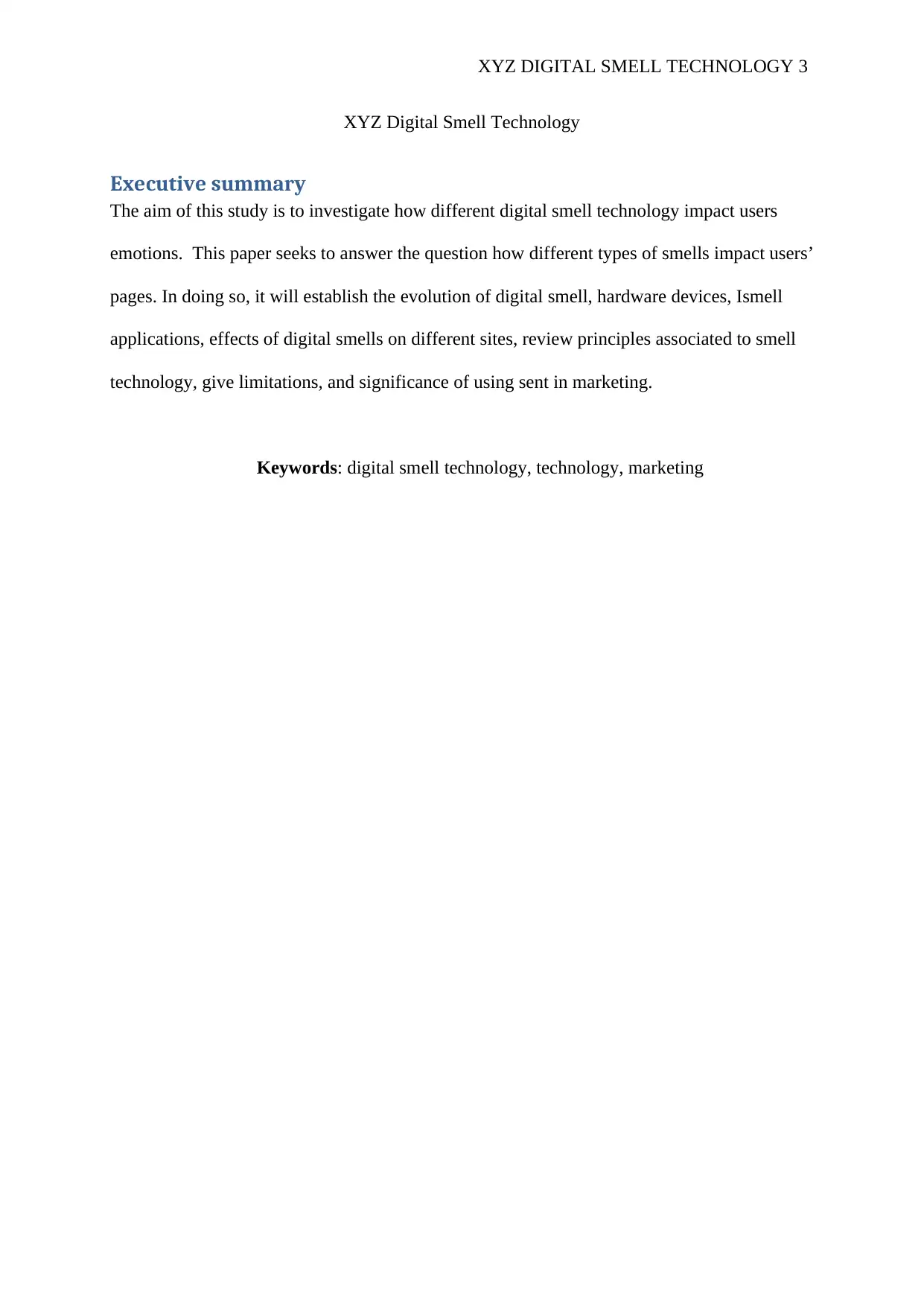
XYZ DIGITAL SMELL TECHNOLOGY 3
XYZ Digital Smell Technology
Executive summary
The aim of this study is to investigate how different digital smell technology impact users
emotions. This paper seeks to answer the question how different types of smells impact users’
pages. In doing so, it will establish the evolution of digital smell, hardware devices, Ismell
applications, effects of digital smells on different sites, review principles associated to smell
technology, give limitations, and significance of using sent in marketing.
Keywords: digital smell technology, technology, marketing
XYZ Digital Smell Technology
Executive summary
The aim of this study is to investigate how different digital smell technology impact users
emotions. This paper seeks to answer the question how different types of smells impact users’
pages. In doing so, it will establish the evolution of digital smell, hardware devices, Ismell
applications, effects of digital smells on different sites, review principles associated to smell
technology, give limitations, and significance of using sent in marketing.
Keywords: digital smell technology, technology, marketing
⊘ This is a preview!⊘
Do you want full access?
Subscribe today to unlock all pages.

Trusted by 1+ million students worldwide
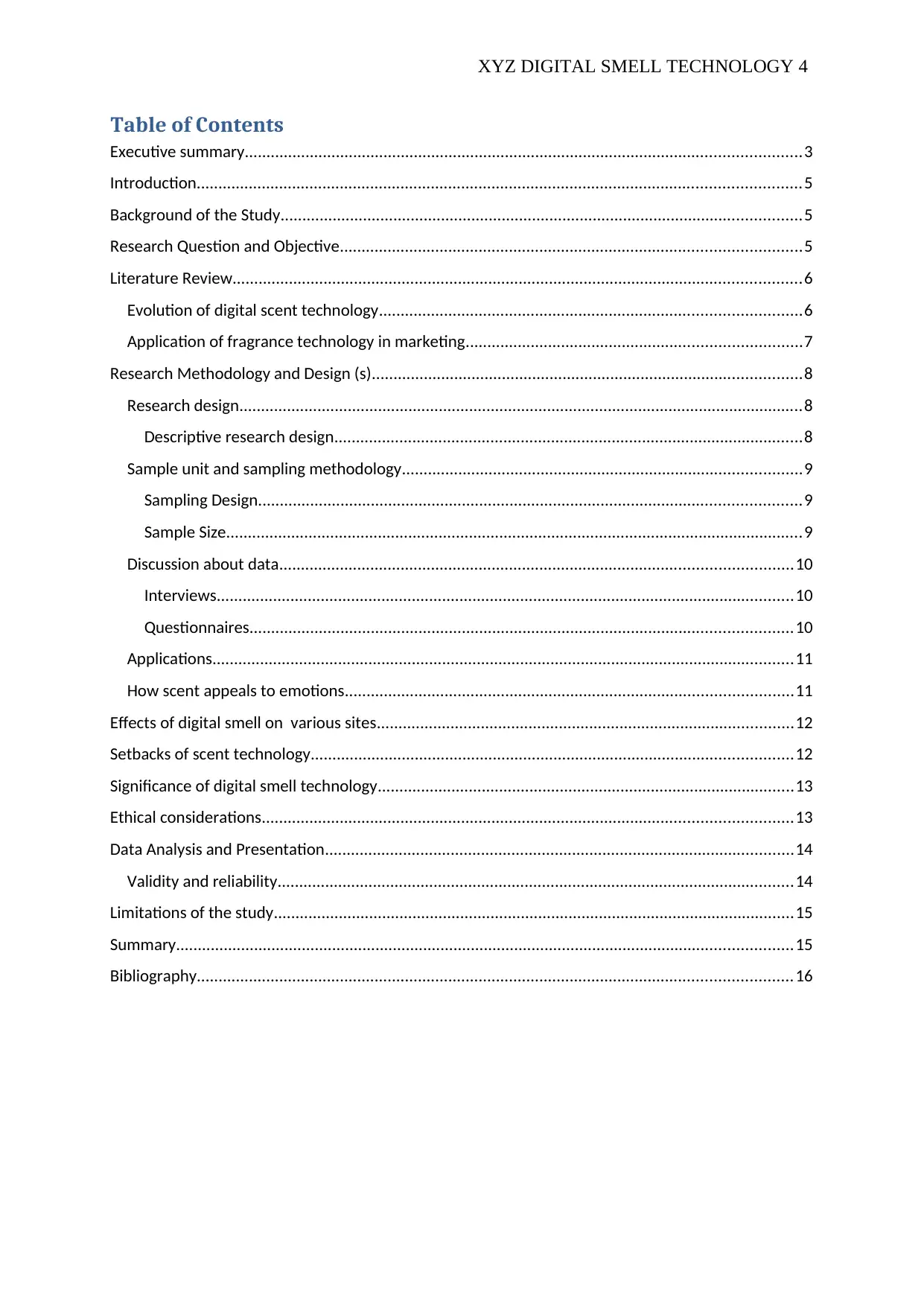
XYZ DIGITAL SMELL TECHNOLOGY 4
Table of Contents
Executive summary................................................................................................................................3
Introduction...........................................................................................................................................5
Background of the Study........................................................................................................................5
Research Question and Objective..........................................................................................................5
Literature Review...................................................................................................................................6
Evolution of digital scent technology.................................................................................................6
Application of fragrance technology in marketing.............................................................................7
Research Methodology and Design (s)...................................................................................................8
Research design..................................................................................................................................8
Descriptive research design............................................................................................................8
Sample unit and sampling methodology............................................................................................9
Sampling Design.............................................................................................................................9
Sample Size.....................................................................................................................................9
Discussion about data......................................................................................................................10
Interviews.....................................................................................................................................10
Questionnaires.............................................................................................................................10
Applications......................................................................................................................................11
How scent appeals to emotions.......................................................................................................11
Effects of digital smell on various sites................................................................................................12
Setbacks of scent technology...............................................................................................................12
Significance of digital smell technology................................................................................................13
Ethical considerations..........................................................................................................................13
Data Analysis and Presentation............................................................................................................14
Validity and reliability.......................................................................................................................14
Limitations of the study........................................................................................................................15
Summary..............................................................................................................................................15
Bibliography.........................................................................................................................................16
Table of Contents
Executive summary................................................................................................................................3
Introduction...........................................................................................................................................5
Background of the Study........................................................................................................................5
Research Question and Objective..........................................................................................................5
Literature Review...................................................................................................................................6
Evolution of digital scent technology.................................................................................................6
Application of fragrance technology in marketing.............................................................................7
Research Methodology and Design (s)...................................................................................................8
Research design..................................................................................................................................8
Descriptive research design............................................................................................................8
Sample unit and sampling methodology............................................................................................9
Sampling Design.............................................................................................................................9
Sample Size.....................................................................................................................................9
Discussion about data......................................................................................................................10
Interviews.....................................................................................................................................10
Questionnaires.............................................................................................................................10
Applications......................................................................................................................................11
How scent appeals to emotions.......................................................................................................11
Effects of digital smell on various sites................................................................................................12
Setbacks of scent technology...............................................................................................................12
Significance of digital smell technology................................................................................................13
Ethical considerations..........................................................................................................................13
Data Analysis and Presentation............................................................................................................14
Validity and reliability.......................................................................................................................14
Limitations of the study........................................................................................................................15
Summary..............................................................................................................................................15
Bibliography.........................................................................................................................................16
Paraphrase This Document
Need a fresh take? Get an instant paraphrase of this document with our AI Paraphraser
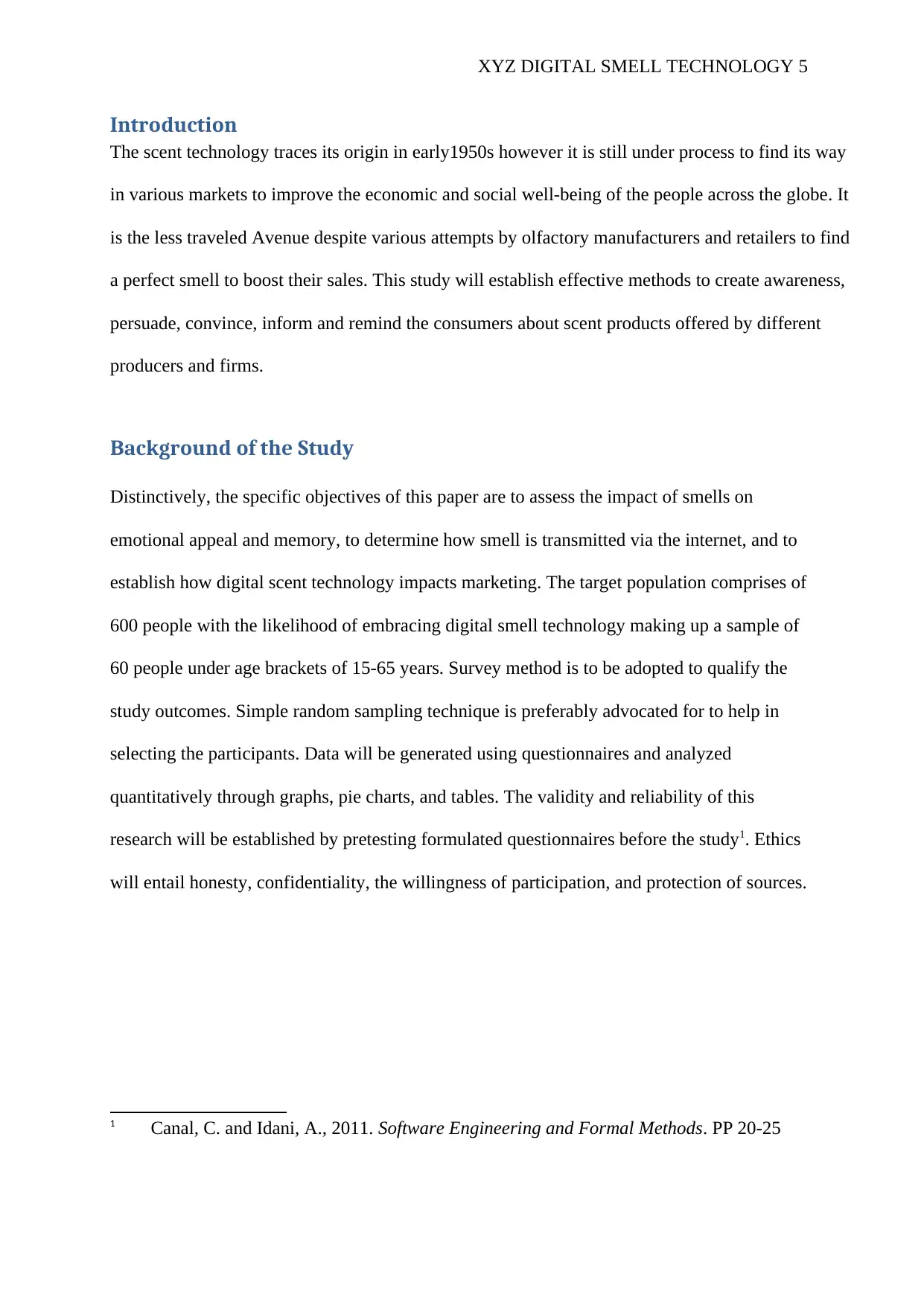
XYZ DIGITAL SMELL TECHNOLOGY 5
Introduction
The scent technology traces its origin in early1950s however it is still under process to find its way
in various markets to improve the economic and social well-being of the people across the globe. It
is the less traveled Avenue despite various attempts by olfactory manufacturers and retailers to find
a perfect smell to boost their sales. This study will establish effective methods to create awareness,
persuade, convince, inform and remind the consumers about scent products offered by different
producers and firms.
Background of the Study
Distinctively, the specific objectives of this paper are to assess the impact of smells on
emotional appeal and memory, to determine how smell is transmitted via the internet, and to
establish how digital scent technology impacts marketing. The target population comprises of
600 people with the likelihood of embracing digital smell technology making up a sample of
60 people under age brackets of 15-65 years. Survey method is to be adopted to qualify the
study outcomes. Simple random sampling technique is preferably advocated for to help in
selecting the participants. Data will be generated using questionnaires and analyzed
quantitatively through graphs, pie charts, and tables. The validity and reliability of this
research will be established by pretesting formulated questionnaires before the study1. Ethics
will entail honesty, confidentiality, the willingness of participation, and protection of sources.
1 Canal, C. and Idani, A., 2011. Software Engineering and Formal Methods. PP 20-25
Introduction
The scent technology traces its origin in early1950s however it is still under process to find its way
in various markets to improve the economic and social well-being of the people across the globe. It
is the less traveled Avenue despite various attempts by olfactory manufacturers and retailers to find
a perfect smell to boost their sales. This study will establish effective methods to create awareness,
persuade, convince, inform and remind the consumers about scent products offered by different
producers and firms.
Background of the Study
Distinctively, the specific objectives of this paper are to assess the impact of smells on
emotional appeal and memory, to determine how smell is transmitted via the internet, and to
establish how digital scent technology impacts marketing. The target population comprises of
600 people with the likelihood of embracing digital smell technology making up a sample of
60 people under age brackets of 15-65 years. Survey method is to be adopted to qualify the
study outcomes. Simple random sampling technique is preferably advocated for to help in
selecting the participants. Data will be generated using questionnaires and analyzed
quantitatively through graphs, pie charts, and tables. The validity and reliability of this
research will be established by pretesting formulated questionnaires before the study1. Ethics
will entail honesty, confidentiality, the willingness of participation, and protection of sources.
1 Canal, C. and Idani, A., 2011. Software Engineering and Formal Methods. PP 20-25
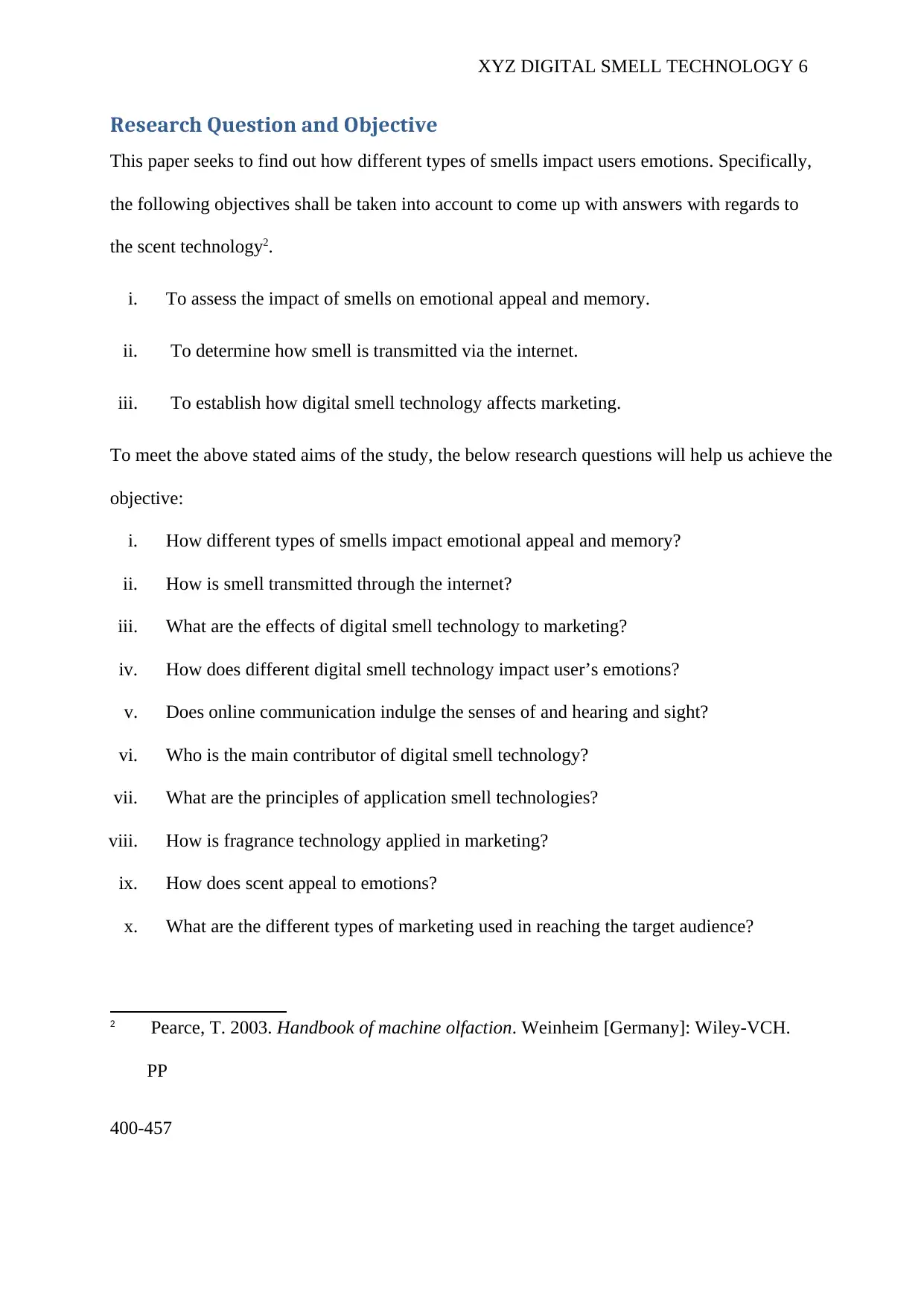
XYZ DIGITAL SMELL TECHNOLOGY 6
Research Question and Objective
This paper seeks to find out how different types of smells impact users emotions. Specifically,
the following objectives shall be taken into account to come up with answers with regards to
the scent technology2.
i. To assess the impact of smells on emotional appeal and memory.
ii. To determine how smell is transmitted via the internet.
iii. To establish how digital smell technology affects marketing.
To meet the above stated aims of the study, the below research questions will help us achieve the
objective:
i. How different types of smells impact emotional appeal and memory?
ii. How is smell transmitted through the internet?
iii. What are the effects of digital smell technology to marketing?
iv. How does different digital smell technology impact user’s emotions?
v. Does online communication indulge the senses of and hearing and sight?
vi. Who is the main contributor of digital smell technology?
vii. What are the principles of application smell technologies?
viii. How is fragrance technology applied in marketing?
ix. How does scent appeal to emotions?
x. What are the different types of marketing used in reaching the target audience?
2 Pearce, T. 2003. Handbook of machine olfaction. Weinheim [Germany]: Wiley-VCH.
PP
400-457
Research Question and Objective
This paper seeks to find out how different types of smells impact users emotions. Specifically,
the following objectives shall be taken into account to come up with answers with regards to
the scent technology2.
i. To assess the impact of smells on emotional appeal and memory.
ii. To determine how smell is transmitted via the internet.
iii. To establish how digital smell technology affects marketing.
To meet the above stated aims of the study, the below research questions will help us achieve the
objective:
i. How different types of smells impact emotional appeal and memory?
ii. How is smell transmitted through the internet?
iii. What are the effects of digital smell technology to marketing?
iv. How does different digital smell technology impact user’s emotions?
v. Does online communication indulge the senses of and hearing and sight?
vi. Who is the main contributor of digital smell technology?
vii. What are the principles of application smell technologies?
viii. How is fragrance technology applied in marketing?
ix. How does scent appeal to emotions?
x. What are the different types of marketing used in reaching the target audience?
2 Pearce, T. 2003. Handbook of machine olfaction. Weinheim [Germany]: Wiley-VCH.
PP
400-457
⊘ This is a preview!⊘
Do you want full access?
Subscribe today to unlock all pages.

Trusted by 1+ million students worldwide
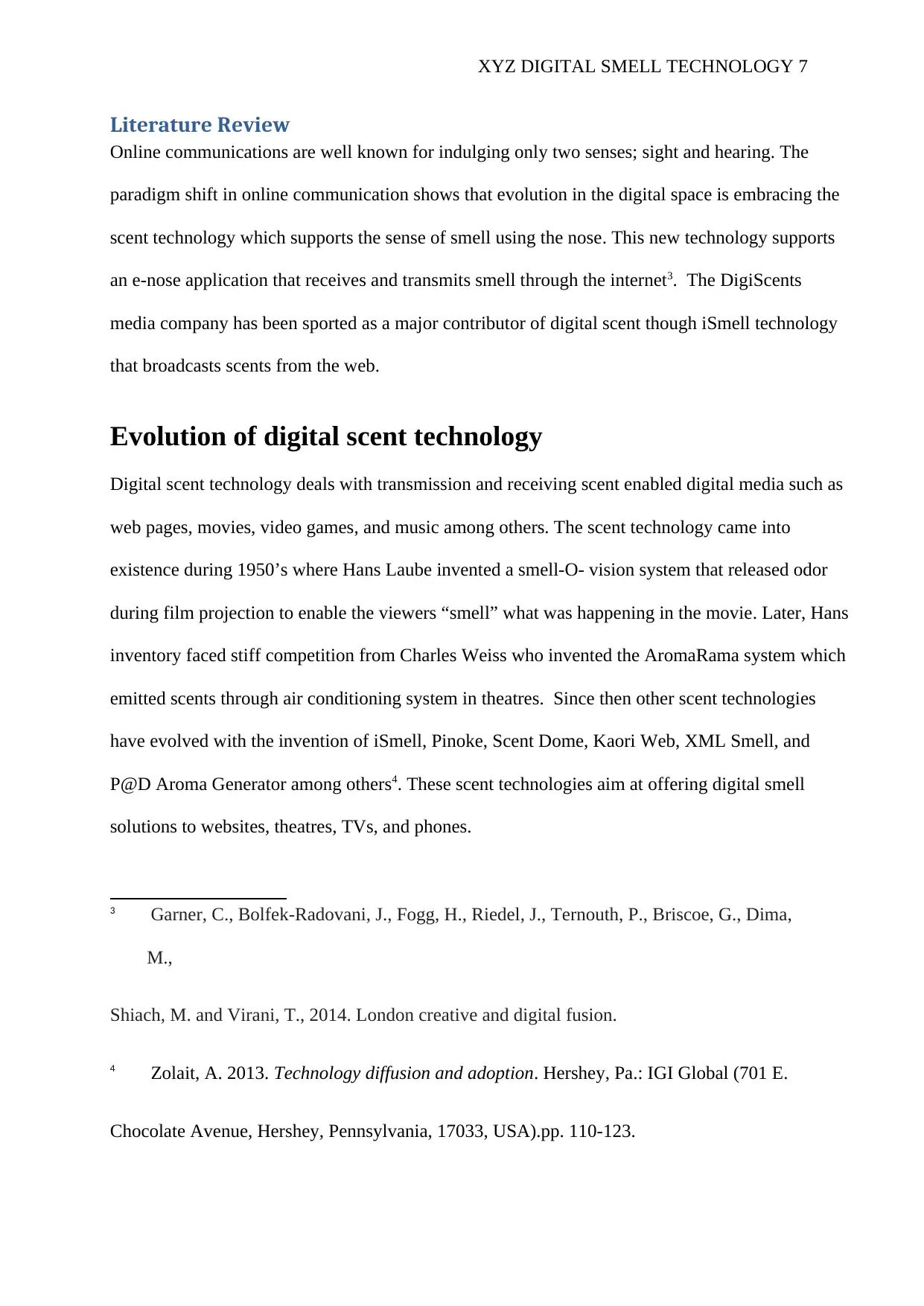
XYZ DIGITAL SMELL TECHNOLOGY 7
Literature Review
Online communications are well known for indulging only two senses; sight and hearing. The
paradigm shift in online communication shows that evolution in the digital space is embracing the
scent technology which supports the sense of smell using the nose. This new technology supports
an e-nose application that receives and transmits smell through the internet3. The DigiScents
media company has been sported as a major contributor of digital scent though iSmell technology
that broadcasts scents from the web.
Evolution of digital scent technology
Digital scent technology deals with transmission and receiving scent enabled digital media such as
web pages, movies, video games, and music among others. The scent technology came into
existence during 1950’s where Hans Laube invented a smell-O- vision system that released odor
during film projection to enable the viewers “smell” what was happening in the movie. Later, Hans
inventory faced stiff competition from Charles Weiss who invented the AromaRama system which
emitted scents through air conditioning system in theatres. Since then other scent technologies
have evolved with the invention of iSmell, Pinoke, Scent Dome, Kaori Web, XML Smell, and
P@D Aroma Generator among others4. These scent technologies aim at offering digital smell
solutions to websites, theatres, TVs, and phones.
3 Garner, C., Bolfek-Radovani, J., Fogg, H., Riedel, J., Ternouth, P., Briscoe, G., Dima,
M.,
Shiach, M. and Virani, T., 2014. London creative and digital fusion.
4 Zolait, A. 2013. Technology diffusion and adoption. Hershey, Pa.: IGI Global (701 E.
Chocolate Avenue, Hershey, Pennsylvania, 17033, USA).pp. 110-123.
Literature Review
Online communications are well known for indulging only two senses; sight and hearing. The
paradigm shift in online communication shows that evolution in the digital space is embracing the
scent technology which supports the sense of smell using the nose. This new technology supports
an e-nose application that receives and transmits smell through the internet3. The DigiScents
media company has been sported as a major contributor of digital scent though iSmell technology
that broadcasts scents from the web.
Evolution of digital scent technology
Digital scent technology deals with transmission and receiving scent enabled digital media such as
web pages, movies, video games, and music among others. The scent technology came into
existence during 1950’s where Hans Laube invented a smell-O- vision system that released odor
during film projection to enable the viewers “smell” what was happening in the movie. Later, Hans
inventory faced stiff competition from Charles Weiss who invented the AromaRama system which
emitted scents through air conditioning system in theatres. Since then other scent technologies
have evolved with the invention of iSmell, Pinoke, Scent Dome, Kaori Web, XML Smell, and
P@D Aroma Generator among others4. These scent technologies aim at offering digital smell
solutions to websites, theatres, TVs, and phones.
3 Garner, C., Bolfek-Radovani, J., Fogg, H., Riedel, J., Ternouth, P., Briscoe, G., Dima,
M.,
Shiach, M. and Virani, T., 2014. London creative and digital fusion.
4 Zolait, A. 2013. Technology diffusion and adoption. Hershey, Pa.: IGI Global (701 E.
Chocolate Avenue, Hershey, Pennsylvania, 17033, USA).pp. 110-123.
Paraphrase This Document
Need a fresh take? Get an instant paraphrase of this document with our AI Paraphraser
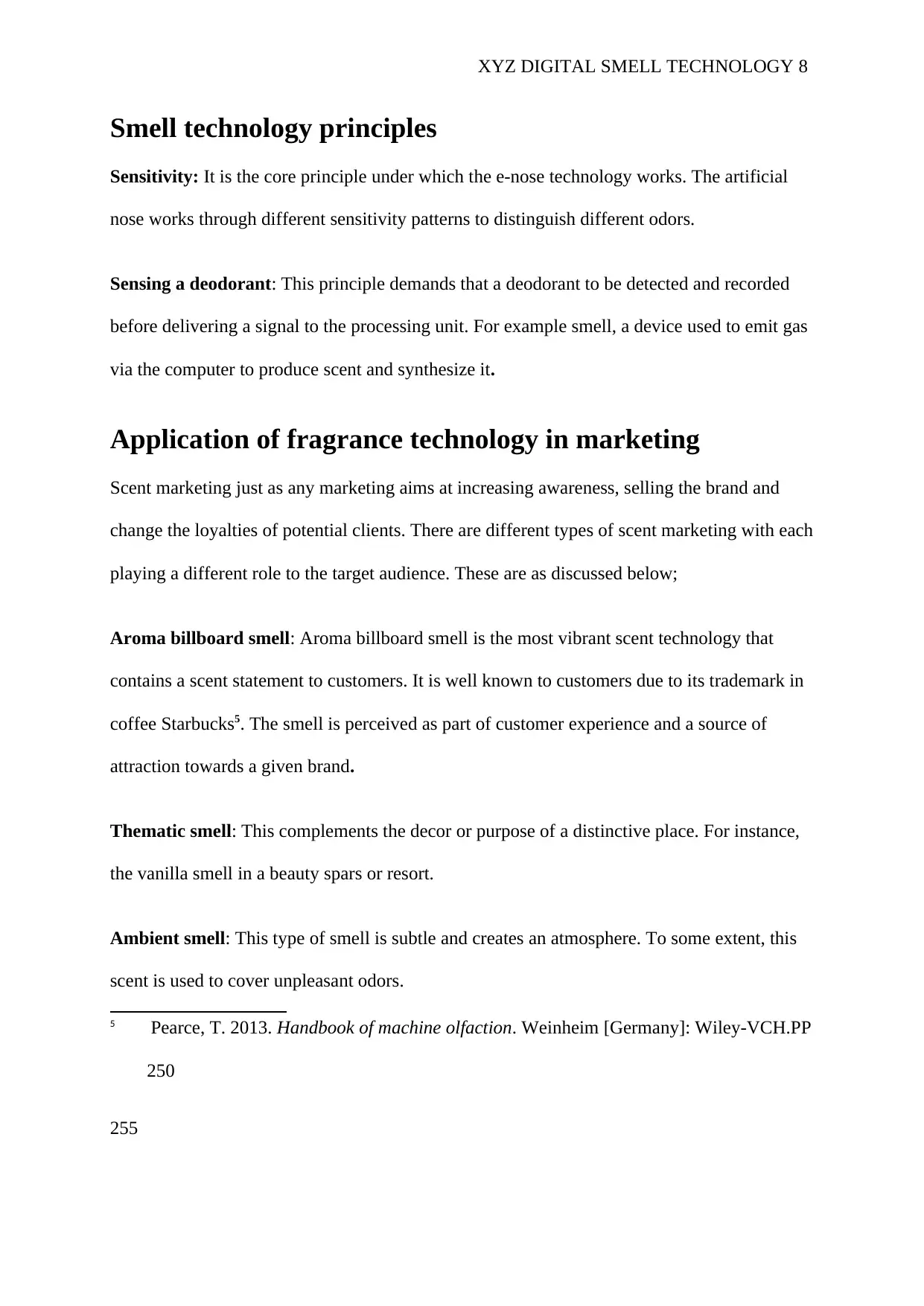
XYZ DIGITAL SMELL TECHNOLOGY 8
Smell technology principles
Sensitivity: It is the core principle under which the e-nose technology works. The artificial
nose works through different sensitivity patterns to distinguish different odors.
Sensing a deodorant: This principle demands that a deodorant to be detected and recorded
before delivering a signal to the processing unit. For example smell, a device used to emit gas
via the computer to produce scent and synthesize it.
Application of fragrance technology in marketing
Scent marketing just as any marketing aims at increasing awareness, selling the brand and
change the loyalties of potential clients. There are different types of scent marketing with each
playing a different role to the target audience. These are as discussed below;
Aroma billboard smell: Aroma billboard smell is the most vibrant scent technology that
contains a scent statement to customers. It is well known to customers due to its trademark in
coffee Starbucks5. The smell is perceived as part of customer experience and a source of
attraction towards a given brand.
Thematic smell: This complements the decor or purpose of a distinctive place. For instance,
the vanilla smell in a beauty spars or resort.
Ambient smell: This type of smell is subtle and creates an atmosphere. To some extent, this
scent is used to cover unpleasant odors.
5 Pearce, T. 2013. Handbook of machine olfaction. Weinheim [Germany]: Wiley-VCH.PP
250
255
Smell technology principles
Sensitivity: It is the core principle under which the e-nose technology works. The artificial
nose works through different sensitivity patterns to distinguish different odors.
Sensing a deodorant: This principle demands that a deodorant to be detected and recorded
before delivering a signal to the processing unit. For example smell, a device used to emit gas
via the computer to produce scent and synthesize it.
Application of fragrance technology in marketing
Scent marketing just as any marketing aims at increasing awareness, selling the brand and
change the loyalties of potential clients. There are different types of scent marketing with each
playing a different role to the target audience. These are as discussed below;
Aroma billboard smell: Aroma billboard smell is the most vibrant scent technology that
contains a scent statement to customers. It is well known to customers due to its trademark in
coffee Starbucks5. The smell is perceived as part of customer experience and a source of
attraction towards a given brand.
Thematic smell: This complements the decor or purpose of a distinctive place. For instance,
the vanilla smell in a beauty spars or resort.
Ambient smell: This type of smell is subtle and creates an atmosphere. To some extent, this
scent is used to cover unpleasant odors.
5 Pearce, T. 2013. Handbook of machine olfaction. Weinheim [Germany]: Wiley-VCH.PP
250
255
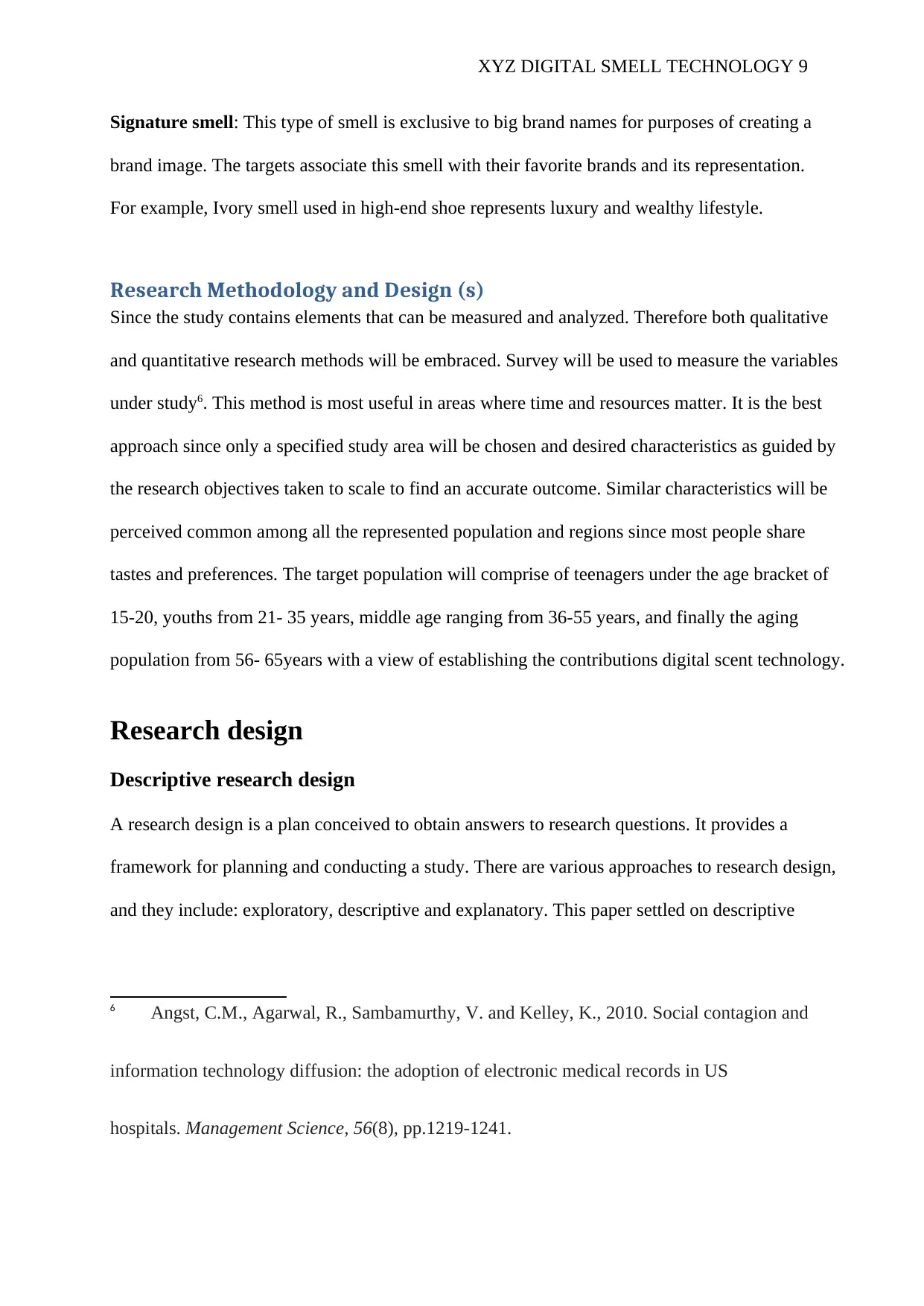
XYZ DIGITAL SMELL TECHNOLOGY 9
Signature smell: This type of smell is exclusive to big brand names for purposes of creating a
brand image. The targets associate this smell with their favorite brands and its representation.
For example, Ivory smell used in high-end shoe represents luxury and wealthy lifestyle.
Research Methodology and Design (s)
Since the study contains elements that can be measured and analyzed. Therefore both qualitative
and quantitative research methods will be embraced. Survey will be used to measure the variables
under study6. This method is most useful in areas where time and resources matter. It is the best
approach since only a specified study area will be chosen and desired characteristics as guided by
the research objectives taken to scale to find an accurate outcome. Similar characteristics will be
perceived common among all the represented population and regions since most people share
tastes and preferences. The target population will comprise of teenagers under the age bracket of
15-20, youths from 21- 35 years, middle age ranging from 36-55 years, and finally the aging
population from 56- 65years with a view of establishing the contributions digital scent technology.
Research design
Descriptive research design
A research design is a plan conceived to obtain answers to research questions. It provides a
framework for planning and conducting a study. There are various approaches to research design,
and they include: exploratory, descriptive and explanatory. This paper settled on descriptive
6 Angst, C.M., Agarwal, R., Sambamurthy, V. and Kelley, K., 2010. Social contagion and
information technology diffusion: the adoption of electronic medical records in US
hospitals. Management Science, 56(8), pp.1219-1241.
Signature smell: This type of smell is exclusive to big brand names for purposes of creating a
brand image. The targets associate this smell with their favorite brands and its representation.
For example, Ivory smell used in high-end shoe represents luxury and wealthy lifestyle.
Research Methodology and Design (s)
Since the study contains elements that can be measured and analyzed. Therefore both qualitative
and quantitative research methods will be embraced. Survey will be used to measure the variables
under study6. This method is most useful in areas where time and resources matter. It is the best
approach since only a specified study area will be chosen and desired characteristics as guided by
the research objectives taken to scale to find an accurate outcome. Similar characteristics will be
perceived common among all the represented population and regions since most people share
tastes and preferences. The target population will comprise of teenagers under the age bracket of
15-20, youths from 21- 35 years, middle age ranging from 36-55 years, and finally the aging
population from 56- 65years with a view of establishing the contributions digital scent technology.
Research design
Descriptive research design
A research design is a plan conceived to obtain answers to research questions. It provides a
framework for planning and conducting a study. There are various approaches to research design,
and they include: exploratory, descriptive and explanatory. This paper settled on descriptive
6 Angst, C.M., Agarwal, R., Sambamurthy, V. and Kelley, K., 2010. Social contagion and
information technology diffusion: the adoption of electronic medical records in US
hospitals. Management Science, 56(8), pp.1219-1241.
⊘ This is a preview!⊘
Do you want full access?
Subscribe today to unlock all pages.

Trusted by 1+ million students worldwide
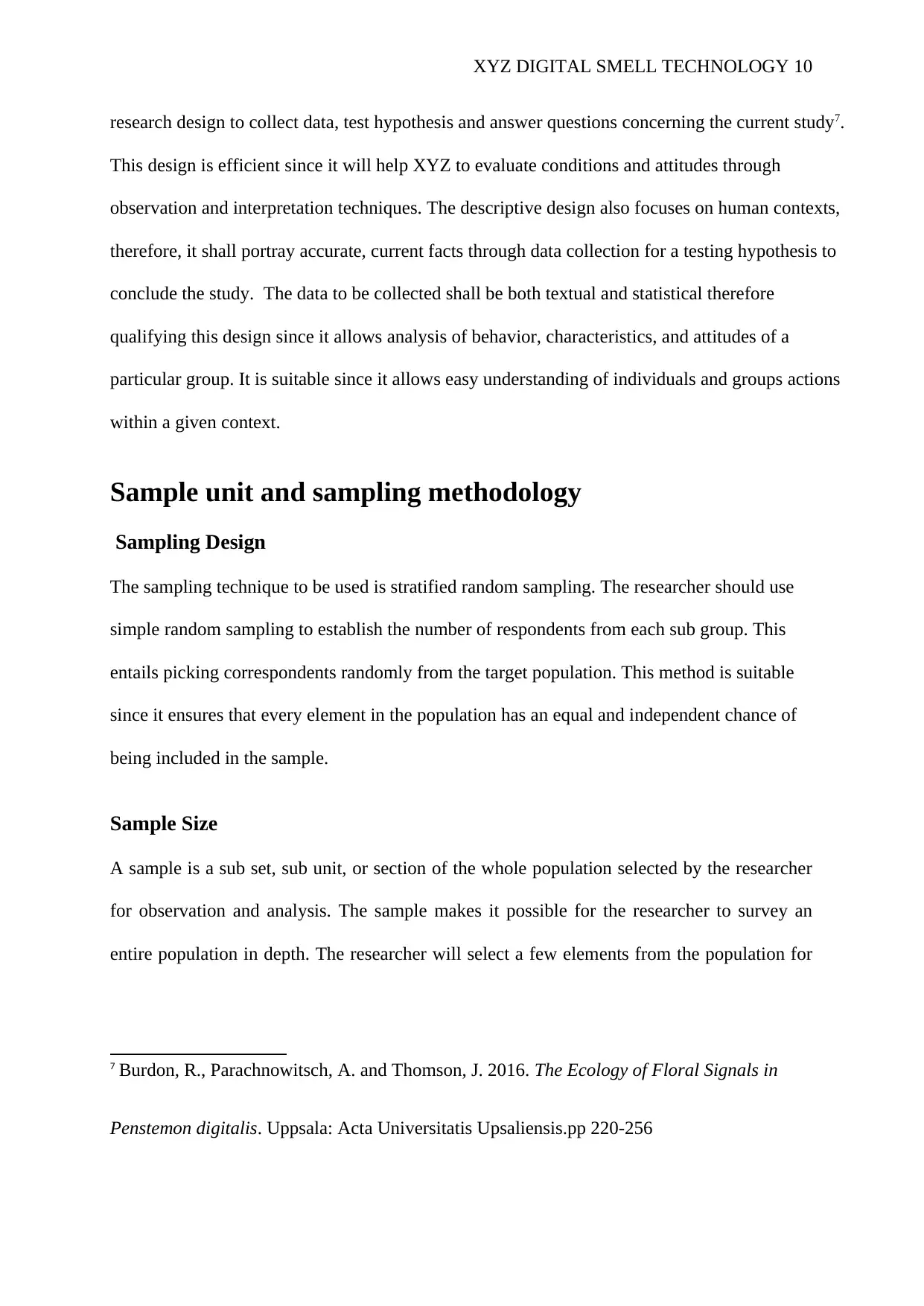
XYZ DIGITAL SMELL TECHNOLOGY 10
research design to collect data, test hypothesis and answer questions concerning the current study7.
This design is efficient since it will help XYZ to evaluate conditions and attitudes through
observation and interpretation techniques. The descriptive design also focuses on human contexts,
therefore, it shall portray accurate, current facts through data collection for a testing hypothesis to
conclude the study. The data to be collected shall be both textual and statistical therefore
qualifying this design since it allows analysis of behavior, characteristics, and attitudes of a
particular group. It is suitable since it allows easy understanding of individuals and groups actions
within a given context.
Sample unit and sampling methodology
Sampling Design
The sampling technique to be used is stratified random sampling. The researcher should use
simple random sampling to establish the number of respondents from each sub group. This
entails picking correspondents randomly from the target population. This method is suitable
since it ensures that every element in the population has an equal and independent chance of
being included in the sample.
Sample Size
A sample is a sub set, sub unit, or section of the whole population selected by the researcher
for observation and analysis. The sample makes it possible for the researcher to survey an
entire population in depth. The researcher will select a few elements from the population for
7 Burdon, R., Parachnowitsch, A. and Thomson, J. 2016. The Ecology of Floral Signals in
Penstemon digitalis. Uppsala: Acta Universitatis Upsaliensis.pp 220-256
research design to collect data, test hypothesis and answer questions concerning the current study7.
This design is efficient since it will help XYZ to evaluate conditions and attitudes through
observation and interpretation techniques. The descriptive design also focuses on human contexts,
therefore, it shall portray accurate, current facts through data collection for a testing hypothesis to
conclude the study. The data to be collected shall be both textual and statistical therefore
qualifying this design since it allows analysis of behavior, characteristics, and attitudes of a
particular group. It is suitable since it allows easy understanding of individuals and groups actions
within a given context.
Sample unit and sampling methodology
Sampling Design
The sampling technique to be used is stratified random sampling. The researcher should use
simple random sampling to establish the number of respondents from each sub group. This
entails picking correspondents randomly from the target population. This method is suitable
since it ensures that every element in the population has an equal and independent chance of
being included in the sample.
Sample Size
A sample is a sub set, sub unit, or section of the whole population selected by the researcher
for observation and analysis. The sample makes it possible for the researcher to survey an
entire population in depth. The researcher will select a few elements from the population for
7 Burdon, R., Parachnowitsch, A. and Thomson, J. 2016. The Ecology of Floral Signals in
Penstemon digitalis. Uppsala: Acta Universitatis Upsaliensis.pp 220-256
Paraphrase This Document
Need a fresh take? Get an instant paraphrase of this document with our AI Paraphraser
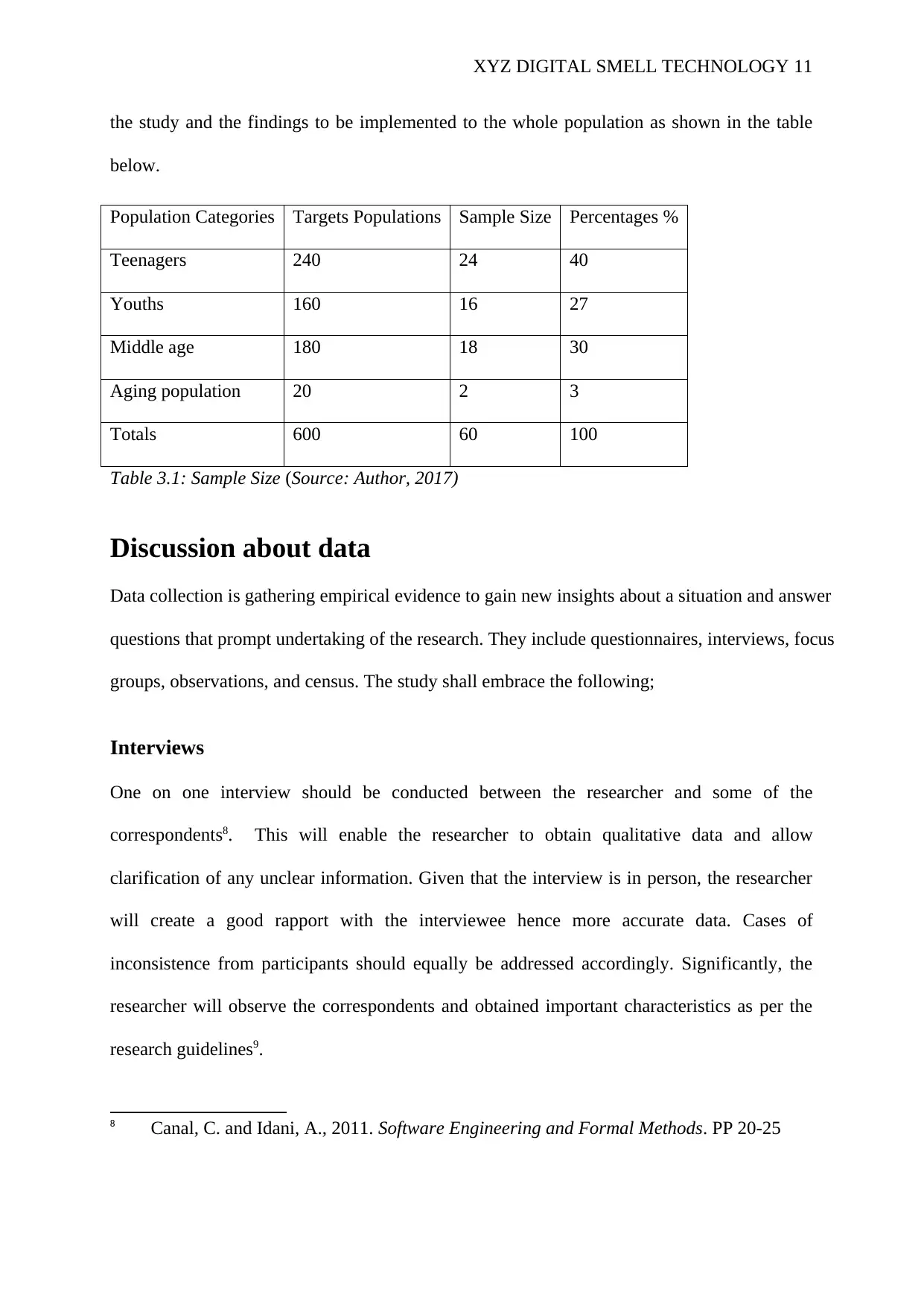
XYZ DIGITAL SMELL TECHNOLOGY 11
the study and the findings to be implemented to the whole population as shown in the table
below.
Population Categories Targets Populations Sample Size Percentages %
Teenagers 240 24 40
Youths 160 16 27
Middle age 180 18 30
Aging population 20 2 3
Totals 600 60 100
Table 3.1: Sample Size (Source: Author, 2017)
Discussion about data
Data collection is gathering empirical evidence to gain new insights about a situation and answer
questions that prompt undertaking of the research. They include questionnaires, interviews, focus
groups, observations, and census. The study shall embrace the following;
Interviews
One on one interview should be conducted between the researcher and some of the
correspondents8. This will enable the researcher to obtain qualitative data and allow
clarification of any unclear information. Given that the interview is in person, the researcher
will create a good rapport with the interviewee hence more accurate data. Cases of
inconsistence from participants should equally be addressed accordingly. Significantly, the
researcher will observe the correspondents and obtained important characteristics as per the
research guidelines9.
8 Canal, C. and Idani, A., 2011. Software Engineering and Formal Methods. PP 20-25
the study and the findings to be implemented to the whole population as shown in the table
below.
Population Categories Targets Populations Sample Size Percentages %
Teenagers 240 24 40
Youths 160 16 27
Middle age 180 18 30
Aging population 20 2 3
Totals 600 60 100
Table 3.1: Sample Size (Source: Author, 2017)
Discussion about data
Data collection is gathering empirical evidence to gain new insights about a situation and answer
questions that prompt undertaking of the research. They include questionnaires, interviews, focus
groups, observations, and census. The study shall embrace the following;
Interviews
One on one interview should be conducted between the researcher and some of the
correspondents8. This will enable the researcher to obtain qualitative data and allow
clarification of any unclear information. Given that the interview is in person, the researcher
will create a good rapport with the interviewee hence more accurate data. Cases of
inconsistence from participants should equally be addressed accordingly. Significantly, the
researcher will observe the correspondents and obtained important characteristics as per the
research guidelines9.
8 Canal, C. and Idani, A., 2011. Software Engineering and Formal Methods. PP 20-25
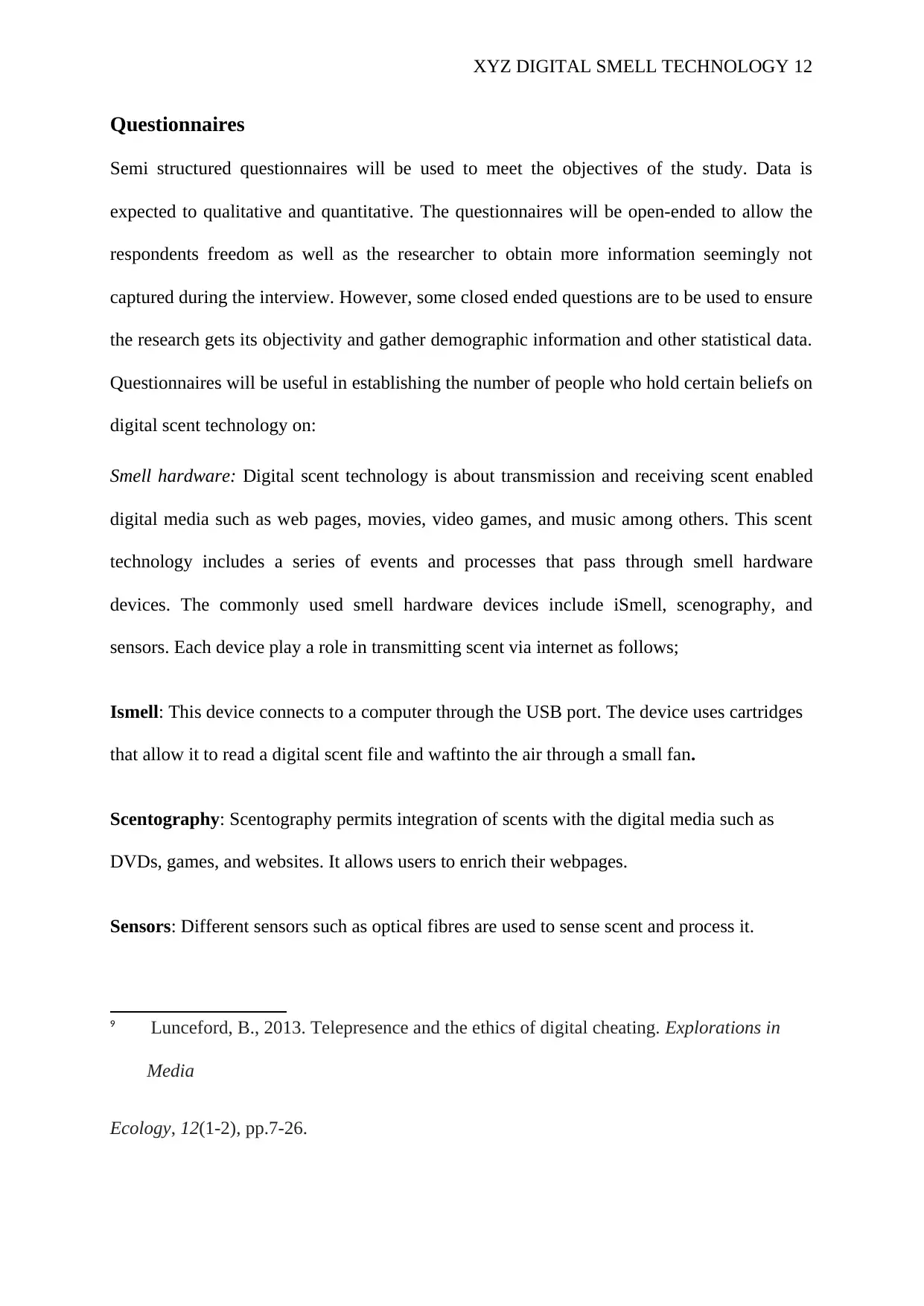
XYZ DIGITAL SMELL TECHNOLOGY 12
Questionnaires
Semi structured questionnaires will be used to meet the objectives of the study. Data is
expected to qualitative and quantitative. The questionnaires will be open-ended to allow the
respondents freedom as well as the researcher to obtain more information seemingly not
captured during the interview. However, some closed ended questions are to be used to ensure
the research gets its objectivity and gather demographic information and other statistical data.
Questionnaires will be useful in establishing the number of people who hold certain beliefs on
digital scent technology on:
Smell hardware: Digital scent technology is about transmission and receiving scent enabled
digital media such as web pages, movies, video games, and music among others. This scent
technology includes a series of events and processes that pass through smell hardware
devices. The commonly used smell hardware devices include iSmell, scenography, and
sensors. Each device play a role in transmitting scent via internet as follows;
Ismell: This device connects to a computer through the USB port. The device uses cartridges
that allow it to read a digital scent file and waftinto the air through a small fan.
Scentography: Scentography permits integration of scents with the digital media such as
DVDs, games, and websites. It allows users to enrich their webpages.
Sensors: Different sensors such as optical fibres are used to sense scent and process it.
9 Lunceford, B., 2013. Telepresence and the ethics of digital cheating. Explorations in
Media
Ecology, 12(1-2), pp.7-26.
Questionnaires
Semi structured questionnaires will be used to meet the objectives of the study. Data is
expected to qualitative and quantitative. The questionnaires will be open-ended to allow the
respondents freedom as well as the researcher to obtain more information seemingly not
captured during the interview. However, some closed ended questions are to be used to ensure
the research gets its objectivity and gather demographic information and other statistical data.
Questionnaires will be useful in establishing the number of people who hold certain beliefs on
digital scent technology on:
Smell hardware: Digital scent technology is about transmission and receiving scent enabled
digital media such as web pages, movies, video games, and music among others. This scent
technology includes a series of events and processes that pass through smell hardware
devices. The commonly used smell hardware devices include iSmell, scenography, and
sensors. Each device play a role in transmitting scent via internet as follows;
Ismell: This device connects to a computer through the USB port. The device uses cartridges
that allow it to read a digital scent file and waftinto the air through a small fan.
Scentography: Scentography permits integration of scents with the digital media such as
DVDs, games, and websites. It allows users to enrich their webpages.
Sensors: Different sensors such as optical fibres are used to sense scent and process it.
9 Lunceford, B., 2013. Telepresence and the ethics of digital cheating. Explorations in
Media
Ecology, 12(1-2), pp.7-26.
⊘ This is a preview!⊘
Do you want full access?
Subscribe today to unlock all pages.

Trusted by 1+ million students worldwide
1 out of 20
Related Documents
Your All-in-One AI-Powered Toolkit for Academic Success.
+13062052269
info@desklib.com
Available 24*7 on WhatsApp / Email
![[object Object]](/_next/static/media/star-bottom.7253800d.svg)
Unlock your academic potential
Copyright © 2020–2025 A2Z Services. All Rights Reserved. Developed and managed by ZUCOL.





